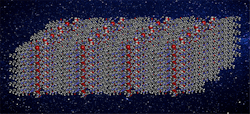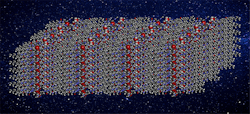Sponge-Like Structure Enhances Desalination
Figure 1. Artificial water channels inserted into a polyamide membrane boost desalination performance. Source: Mihail Barboiu, Institut Européen des Membranes.
A process that creates crosslinked, hybrid advanced water channel-polyamide (AWC-PA) nanoparticles bound together in novel sponge-like structures (Figure 1) promises more efficient desalination, believe its developers, an international team of researchers based in France, Saudi Arabia, and Italy. During testing under industrial conditions, the biomimetic desalination membranes demonstrated 75% higher flow and 12% less energy consumption than those currently used in commercial facilities.AWCs are synthetic compounds that form pores permeable to water molecules while rejecting ions.
Up to now, a lack of fundamental understanding of how best to incorporate AWCs, starting from their colloidal self-assembled superstructures, at the nanoscale to facilitate the selective transport of water has hampered optimization, say the researchers.
The key challenge is the need for adaptive gentle interaction between the PA and water channels to prevent the formation of defects, the team found.
A recent article in Nature Nanotechnology reports on tests of the new membranes at 65 bar applied pressure with a 35,000-ppm sodium chloride feed solution at pH 8. “This is representative of seawater desalination and crossflow conditions of full-scale systems,” notes Mihail Barboiu, research director at the Institut Européen des Membranes, Montpellier, France, which is coordinating the work.
“To assess the performance of the bio-inspired membranes with real seawater, low-recovery experiments were also performed using the American Standard for Testing and Materials recipe for substitute ocean water as feed solution,” he adds.
The membranes sustained their performance even when exposed to relatively harsh environments representative of real systems, where membranes undergo cycles of physical and chemical cleaning, often involving acidic, basic or amphiphilic compounds.
The researchers have considered several methods to handle the challenges of scaling-up the new membranes while at the same time improving their performance both in terms of permeability and selectivity, says Barboiu.
“One of the creative strategies is to combine the classical polyamide reverse osmosis membrane material, known for its scalability via integration within a typical roll-to-roll processing system, with the highly permeable and selective AWCs. We need add only one more step to the classical PA production process to achieve this,” he explains.
In fact, the next phase of work will focus on implementing roll-to-roll production of the new membranes.
The process already has attracted interest from a number of industrial concerns, states Barboiu.

